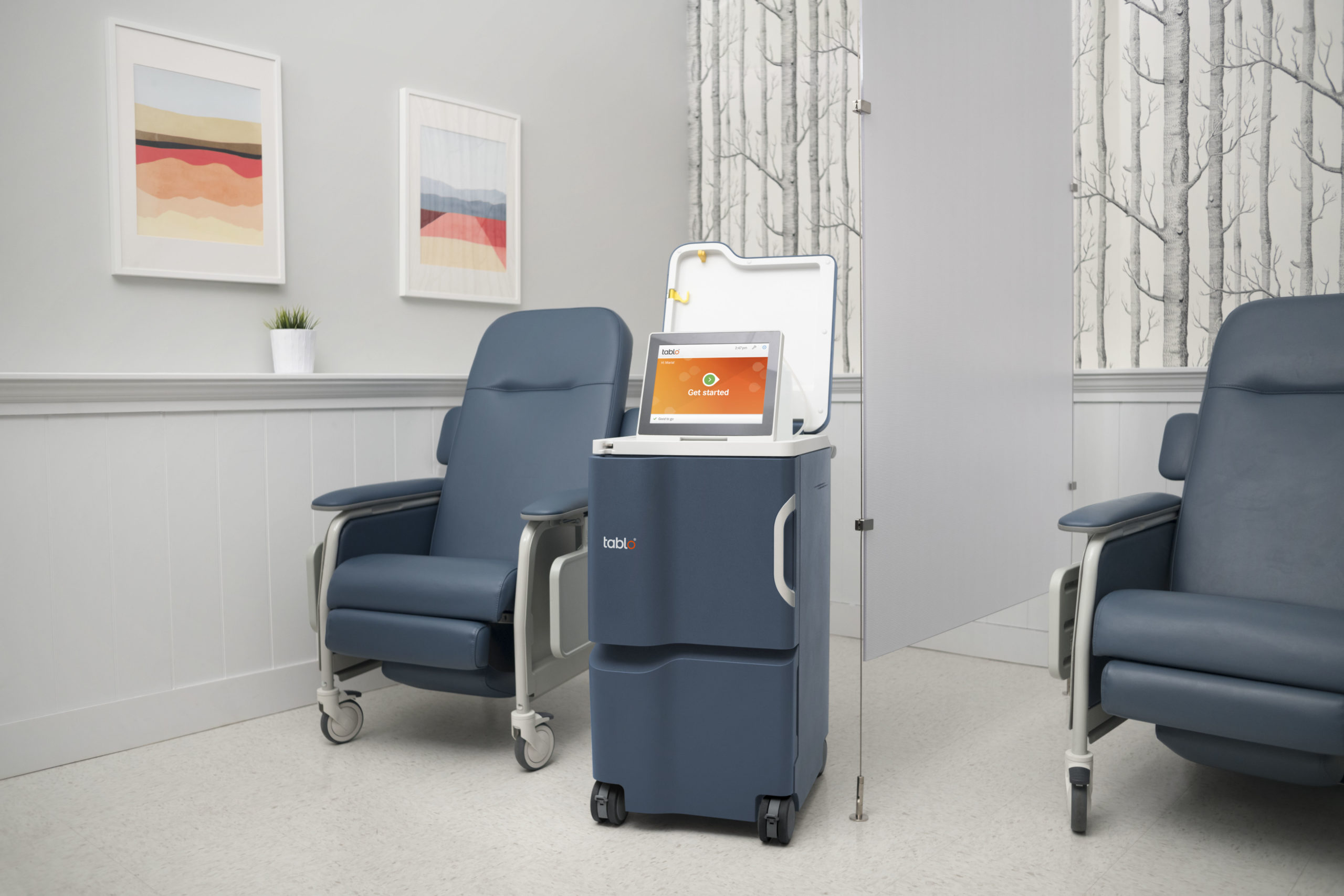Keys to Success for Bringing Acute Dialysis Services In-House

Summary
Stamford Health nursing, nephrology and clinical operations stakeholders describe the fundamental elements that enabled a successful total conversion from outsourced to insourced acute dialysis services, and how the program is doing a year later.
Stamford Health, an independent health system in Fairfield County, CT, that includes the 305-bed, acute care Stamford Hospital, serves a large, diverse and growing kidney disease patient population. Over the past few years, the hospital’s demand for acute dialysis services has been rising, an issue exacerbated by the pandemic.
In the fall of 2021, Stamford Health Chief Nursing Officer and Senior Vice President of Patient Care Services, Ellen Komar, MPA, BSN, RN, NEA-BC, Medical Director of Acute Inpatient Dialysis Services, Revekka Babayev, MD, and other administrators began exploring alternatives that would align with their patient-centered organizational mission to provide the highest quality of care to everyone they serve.
“We are always looking at innovative new technology, and thinking about ways we can do things smarter and better, and provide better care for our patients,” says Komar. “That’s when we came across the Tablo® Hemodialysis System, and based on its clinical versatility and simplicity, we began seriously considering bringing our dialysis services in-house.”
For the Stamford Health team, the success of this significant endeavor was dependent on three key elements: trust, timing and teamwork.
For the Stamford Health team, the success of this significant endeavor was dependent on three key elements: trust, timing and teamwork.
Building an in-house acute dialysis service line from the ground up, including treatments from the ICU to bedside, is a complex initiative. It needed to be done in a seamless, cost-effective way and in-house nurses, physicians and other staff needed to be trained to manage treatments on a new system for acute hemodialysis care throughout the hospital.
Trust in Teams and Technology
Hospital administration and clinical teams began meeting with the Outset Medical team, performed a pro forma financial analysis, and the Stamford Health teams vetted the proposal with all stakeholders.
“At first blush the conversion seemed cost prohibitive, but we were surprised that this actually was going to be somewhat of a cost savings for us,” says Komar.
The decision was made to end the outsourced provider contract and go live on May 16, 2022, with a full in-house acute dialysis service using a fleet of Tablo consoles, capable of delivering dialysis up to 24 hours. For the Stamford Health team, this critical undertaking would require full buy-in and coordination across all clinical teams, and trust in the Outset Medical team to help ensure a smooth transition and uninterrupted care of their dialysis patients.

The hemodialysis and clinical operations staff including Rosanne Casey, MSN, RN, CNL, Nurse Manager, Hemodialysis Program, Andrea Trindade, BSN, RN, Assistant Nurse Manager, Hemodialysis Program, and Roseann Cardi, MSN, CRRN, RN, Senior Director of Clinical Operations, were enthusiastic about launching their own acute dialysis services from the ground up, and growing the skills of their ICU and hemodialysis nursing teams.
For Trindade, a critical factor that helped her and the team gain trust in Tablo being up to the task was the system’s focus on patient safety.
“Safety is the number one thing that really stuck out to me,” she says. “Tablo is not only simple, but also designed from the inside out to be safe. It puts all of us at ease, and the nephrologists too. It speaks a lot to what our organization is all about, always putting patients first.”
Efficiency in Training
“Once we got the green light, we received the new equipment ahead of time, and things moved pretty quickly. The project team at Outset was amazing,” says Cardi.
Casey says that with the clock ticking toward go-live day, the dialysis and ICU nurse trainings went very smoothly with the Outset team and the step-by-step touchscreen guidance built into Tablo.
Komar explains that the switchover from the old machines to Tablo needed to happen at midnight on May 16, with no room for error. “We needed to ensure all the pieces were in place because we could not be without acute dialysis services. Thankfully, the entire team was amazing, and they were so well prepared,” she says.
Trindade, who has been working in dialysis for years on many types of traditional machines, was a bit skeptical about the new device at first. “I was amazed that such intuitive technology was built into something so small and unassuming,” she says. “I was very impressed during my training because in the past to become 100% confident in a machine, especially with troubleshooting, would take much longer. With this machine, the training is much shorter and sweeter.”
Casey also notes that having their ICU nurses also trained on Tablo was an important component for success of the new program. “Our ICU nurses were trained to monitor the machine when a patient is on long-duration treatment up to 24 hours. Treatment is initiated by the dialysis nurse, but once the patient is stable on Tablo, the ICU nurse now can manage the patient and the machine. We’ve gotten very good feedback from the staff with that. Once they got the swing of it, they really appreciated how simple Tablo was compared to our previous devices.”
Prime Example of Teamwork in Acute Dialysis Services
Komar notes that having their nursing staff’s clinical expertise was key in helping get the program off the ground as the clock struck midnight on go-live day. The Outset team was there onsite to help ensure that the physicians and nurses felt comfortable and confident as they were prescribing and performing their first acute dialysis services on the new consoles.
“We had such a strong team on both sides,” says Casey. “We really had to do everything from scratch, from learning how to order things to our policies and procedures. It truly took a village, but when we went live, we were ready thanks to the support that we received from Outset. Their team was there to assist us at all hours of the day.”

One Year In: Control and Efficiency
Almost a year since their go-live, the Stamford Health team looked back on how their in-house acute dialysis services are going.
For Dr. Babayev, one of the biggest benefits of Tablo is its clinical versatility and prescription flexibility, that allows her to personalize dialysis treatment and utilize staff efficiently, with one machine.
“If a patient needs ultrafiltration only, there’s no need for me to do clearance, or if they just need six hours of clearance followed by ultrafiltration, I can do that,” she says. “I think this is really appealing. If we are planning an IHD treatment, but the patient becomes unstable, I don’t have to stop treatment and bring in a different machine for PIRRT [prolonged intermittent renal replacement therapy]. That’s the beauty of it. Tablo saves time, it’s more efficient, I can pivot on the fly to whatever is needed, and we’ve had excellent outcomes. That flexibility is something we didn’t have with our former set up, and I think it makes more sense in terms of patient care and allowing us a lot more control.”
Casey notes that from a documentation standpoint, the TabloHub dashboard provides all the data she needs. “Everything that a Department of Public Health surveyor is going to ask for, I can pull up at a click of a button. All the service reports, treatment reports, chloramine testing, everything is right there. It saves a lot of paper and just ease of access when you need the information quickly.”
“We are data driven and so having all the patient treatment information available helps us with all of our initiatives, and as we plan for how we want to grow the program,” adds Cardi.
About Stamford Health
Stamford Health is a non-profit independent healthcare system with more than 3,800 employees committed to caring for the community through a wide range of high-quality health and wellness services. Patients and their families receive expert, compassionate care through the system’s 305-bed Stamford Hospital; Stamford Health Medical Group, with more than 40 offices in lower Fairfield County offering primary and specialty care; a growing number of ambulatory locations across the region; and support through the Stamford Hospital Foundation. Dedicated to being the community’s most trusted healthcare partner, Stamford Health puts patients first to build long-lasting relationships. For more information, visit StamfordHealth.org. Like us on Facebook and follow us on Twitter, Instagram, YouTube, and LinkedIn.
The views and opinions expressed herein represent the personal opinions of the facility staff, and do not represent the views or opinions of other persons, institutions or organization.

